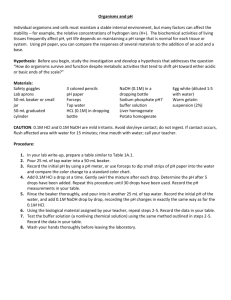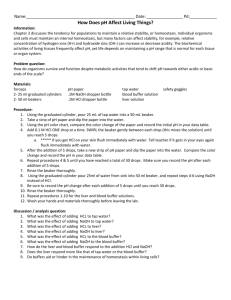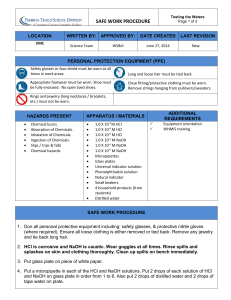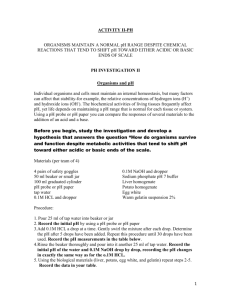Biology 6 - Christopher-Bio6
advertisement
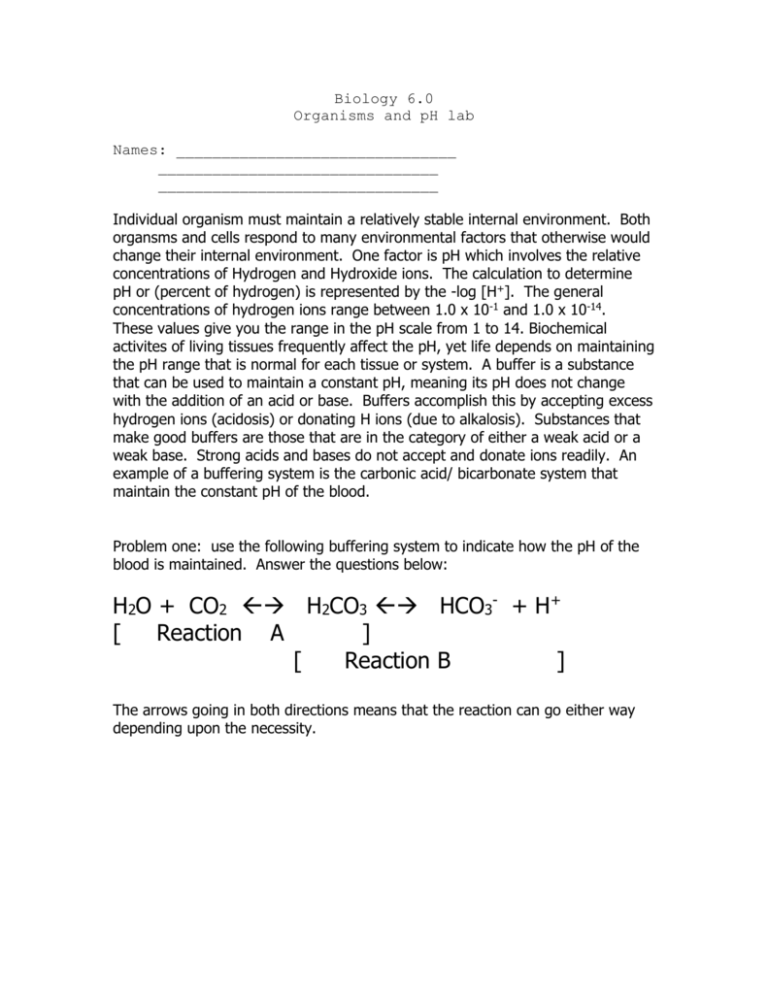
Biology 6.0 Organisms and pH lab Names: _______________________________ _______________________________ _______________________________ Individual organism must maintain a relatively stable internal environment. Both organsms and cells respond to many environmental factors that otherwise would change their internal environment. One factor is pH which involves the relative concentrations of Hydrogen and Hydroxide ions. The calculation to determine pH or (percent of hydrogen) is represented by the -log [H+]. The general concentrations of hydrogen ions range between 1.0 x 10-1 and 1.0 x 10-14. These values give you the range in the pH scale from 1 to 14. Biochemical activites of living tissues frequently affect the pH, yet life depends on maintaining the pH range that is normal for each tissue or system. A buffer is a substance that can be used to maintain a constant pH, meaning its pH does not change with the addition of an acid or base. Buffers accomplish this by accepting excess hydrogen ions (acidosis) or donating H ions (due to alkalosis). Substances that make good buffers are those that are in the category of either a weak acid or a weak base. Strong acids and bases do not accept and donate ions readily. An example of a buffering system is the carbonic acid/ bicarbonate system that maintain the constant pH of the blood. Problem one: use the following buffering system to indicate how the pH of the blood is maintained. Answer the questions below: H2O + CO2 H2CO3 HCO3- + H+ [ Reaction A ] [ Reaction B ] The arrows going in both directions means that the reaction can go either way depending upon the necessity. Think about this situation. 1. _____________________. If someone is hyperventilating what gas are they releasing at a faster rate than normal? 2. _____________________. How is your body going to replace that depleting gas? (Which reaction will INITIALLY have to take place and in which direction will it go?) 3. _______________. Write on the line the chemical that is NOW starting to become lower in concentration because of the reaction in number 2. 4. ____________________. What reaction is now going to have to take place in order to replace the lost chemical in number 3? (Again, which reaction letter and which direction) 5. ________________. What compounds needed to combine in order to make the compound for the answer in number 3? 6. Explain what is going to happen to the pH of this system if all of the previous events are occurring. Will it increase? Decrease? And why? ____________________________________________________________ ____________________________________________________________ ____________________________________________________________ Problem Two: What effect does an acid have on a non-biological material such as tap water? Pour 25 mL of tap water into a 50 mL beaker. Record the initial pH of the tap water using Hydrion paper. Add .1M HCL a drop at a time, swirling to mix the contents after each drop until 5 drops have been added. Record the pH. Continue to add 5 additional drops and record the pH after each 5 drop interval *Make sure to swirl before recording. Stop once you hit 30 drops in the tap water. Fill in table one found at the end of this lab. 1. _____________ What is the initial pH reading? 2. ______________What is the final pH reading? 3. ______________Did the water’s pH increase or decrease as you added HCL? 4. ______________In terms of concentration of Hydrogen, what was the difference between your initial and final pH readings? Problem Three: Repeat the same procedure as problem two, but this time use .1M NaOH. Record your data in table one and answer the following questions. 1.________________ What is the initial pH reading? 2. _______________ What is the final pH reading? 3. _______________ In terms of concentration of Hydrogen (making sure the answer is a positive number) what is the difference between the final and initial pH? 4. _______________ Which substance, NaOH or HCl had more of an effect on the pH of the water? Problem Four: What effect does pH have on a biological material. In this part of the lab you will be assigned on biological material which could be either potato, liver, egg white, or warm gelatin. Note: You will be testing this COLORED materials with hydrion paper which relies on the change in color. Try your best to see a different in the paper color due to pH not due to the substance you are putting on the strip. ______________________________ Our assigned biological material was…. Using the same method of 5 drops of HCl per interval and then in a separate trial 5 drops of NaOH, but instead of 25 mL of water you will need 25 mL of the biological material. Record your results in table ONE. 1. __________________. Initial pH before you added HCl. 2. __________________. Final pH after you added 30 drops of HCl. 3. __________________. In terms of concentration of H, how much more acidic was the material after 30 drops? 4. __________________. Initial pH before you added NaOH. 5. __________________. Final pH after you added 30 drops of NaOH. 6. __________________. Difference in concentration of Hydrogen ions before and after the addition of NaOH. Once you have completed, add your data to the board and copy down data from the other groups for the other three materials. Problem FIVE: Now you are going to test an actual buffer for its capacity to resist changes in pH. Use the same procedure with the HCl and NaOH and record the results up to 30 drops. 1.____________________. Once you reached 30 drops, what was the overall change in Hydrogen concentration? Table One: Solutions Tested Drops added Tap water Biologial material Buffer pH after addition of .1 M HCl 0 5 10 15 20 25 30 pH after addition of .1M NaOH 0 5 10 15 20 25 30 Table Two: Biological Material Initial reading before HCl Final Reading after HCl Initial Reading before NaOH Final Reading after NaOH 1. Create a bar graph which will compare the results of the biological substance before and after the addition of the 30 drops of HCl and NaOH. (i.e – there should be a bar for the pH of liver before any addition of HCl, a bar that has the pH of liver after 30 drops of HCl, and a bar that has the pH of liver after 30 drops of NaOH) You will use one bar graph to show all biological substances used. Please use averages of the groups data. There should be a total of 12 bars on your graph. 3 bars/biological material. Summary Questions: In a cohesive paragraph, answer the following questions. The order does not necessarily need to be the order in which they are asked, but I should be able to tell that ALL questions have been answered. 1. What biological material used in this lab responded the most to the addition of HCl? 2. What biological material used responded most to the addition of NaOH? 3. Were the results of problem five, with the buffer system, more like the results of the tap water or your biological material problems? 4. What might that say about the biological materials that you used? 5. In reference to problem one, what are individuals generally told to do when they are hyperventilating such as on a plane or during a panic attack? Why do you think they are told to do so? What is that doing for their body?

